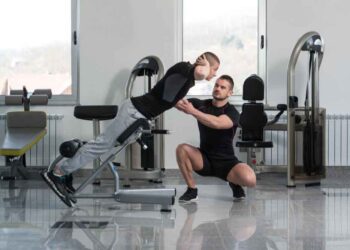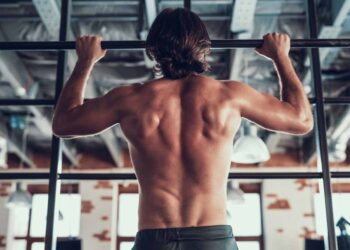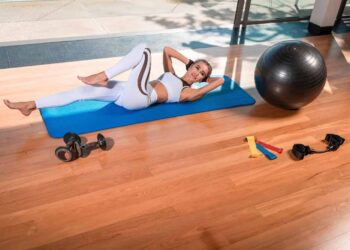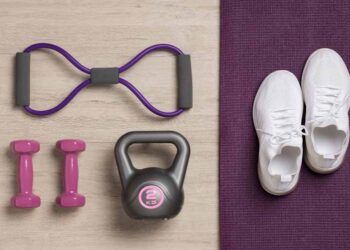Are you struggling to achieve optimal hamstring growth in your strength training routine? Look no further than the deadlift, a powerhouse exercise that targets multiple muscle groups, including the hamstrings. But are you using the right deadlift variation and proper form to unlock its full potential?
Join us as we delve into the world of deadlifts, exploring traditional deadlifts and Romanian deadlifts, their benefits, the muscles they work, and the correct technique to maximize your gains. Discover how incorporating deadlifts into your workout program can lead to increased strength, muscle growth, improved posture, and enhanced athletic performance.
Key Takeaways:
- Deadlifts are highly effective for hamstring growth and overall strength development.
- Traditional deadlifts and Romanian deadlifts target specific muscle groups and offer varied benefits.
- Proper form, including a neutral spine and engagement of the correct muscle groups, is crucial for maximizing effectiveness and preventing injuries.
- Incorporating progressive overload, proper nutrition, and accessory exercises can enhance deadlift performance.
- Rest and recovery are essential for allowing muscles to repair and strengthen, optimizing deadlift training results.
Muscles Worked in Deadlifts: Hamstrings, Glutes, Lower Back, Quadriceps, and Core
Deadlifts are a compound exercise that engage multiple muscle groups, making them an efficient and effective choice for strength training. The primary muscles targeted during deadlifts include the hamstrings and glutes. These powerhouse muscles play a vital role in the initial lift off the ground and the extension of the hips, providing the driving force for the movement.
In addition to the hamstrings and glutes, deadlifts also work the lower back. The muscles of the lower back, known as the erector spinae, play a crucial role in maintaining spinal stability and proper alignment throughout the lift. By strengthening the lower back, deadlifts contribute to a strong and resilient core.
The quadriceps, located at the front of the thighs, are also engaged during the deadlift. These muscles assist in extending the knee and providing support throughout the movement. By involving the quadriceps, deadlifts promote balanced leg development and overall lower body strength.
Lastly, deadlifts require significant activation of the core muscles. The core, which includes the abdominals and obliques, provides important support and stability during the lift. A strong core enhances overall strength and helps maintain proper form throughout the exercise.
With its ability to target multiple muscle groups simultaneously, the deadlift is a highly effective exercise for building strength and muscle mass in the hamstrings, glutes, lower back, quadriceps, and core.
“The deadlift is often referred to as the king of all exercises because it trains so many muscles in a single movement.” – Arnold Schwarzenegger
| Muscle Group | Main Muscles Worked |
|---|---|
| Hamstrings | Primary movers for initial lift off the ground and hip extension |
| Glutes | Assist in hip extension and provide power for the movement |
| Lower Back | Maintains spinal stability and proper alignment |
| Quadriceps | Supports knee extension and stability |
| Core | Provides vital support and stability throughout the lift |
Benefits of Deadlifts: Increased Strength, Muscle Growth, Improved Posture, Enhanced Athletic Performance
Deadlifts offer numerous benefits for individuals looking to improve their strength, build muscle, correct posture, and enhance athletic performance. By targeting multiple muscle groups, deadlifts promote overall strength and muscle growth. This compound exercise engages the hamstrings, glutes, lower back, quadriceps, and core, providing a full-body workout that challenges and strengthens various muscle fibers.
“Deadlifts are the king of exercises when it comes to building strength and muscle. They work your body from head to toe, making it a highly effective compound movement.”
One of the key benefits of deadlifts is increased strength. The exercise requires the lifter to lift a heavy load from the ground, which builds overall strength and power. Deadlifts also stimulate muscle growth, particularly in the hamstrings, glutes, and lower back. The combination of heavy lifting and targeted muscle engagement leads to hypertrophy and muscle development over time.
In addition to increased strength and muscle growth, deadlifts contribute to improved posture. As deadlifts engage the muscles of the posterior chain, including the hamstrings, glutes, and erector spinae, they help to align the spine and improve posture. Regularly performing deadlifts can correct muscle imbalances and strengthen the muscles responsible for maintaining proper posture.
Moreover, deadlifts translate to enhanced athletic performance. The exercise mimics movements required in sports, such as jumping and sprinting, making it a valuable addition to any athletic training program. By strengthening the muscles utilized in these movements, deadlifts can improve an individual’s power, explosiveness, and overall athletic performance.
| Benefit | Description |
|---|---|
| Increased Strength | Deadlifts target multiple muscle groups, leading to overall strength gains. |
| Muscle Growth | The compound nature of deadlifts stimulates muscle hypertrophy, especially in the hamstrings, glutes, and lower back. |
| Improved Posture | By engaging the muscles of the posterior chain, deadlifts help correct muscle imbalances and improve posture. |
| Enhanced Athletic Performance | Deadlifts mimic movements required in sports, improving power, explosiveness, and athletic performance. |
Proper Deadlift Form: Mechanics and Technique for Maximum Effectiveness
Mastering proper deadlift form is crucial not only for maximizing your effectiveness in the exercise but also for preventing injuries. By understanding the key elements of proper form, you can ensure that you are engaging the appropriate muscle groups and minimizing the risk of strains or other issues. Let’s dive into the mechanics and technique of the deadlift.
First and foremost, maintaining a neutral spine is imperative during the deadlift. This means keeping your back straight and avoiding rounding or excessive arching. A neutral spine helps distribute the load evenly and protects your lower back.
Additionally, you should keep the barbell close to your body throughout the movement. This ensures that the load is distributed properly, minimizing unnecessary strain on your back and allowing for efficient force transfer from your legs and hips.
The mechanics of the deadlift involve a hip-hinge movement. As you lower the weight, your hips should move back, allowing them to lower below your shoulders. This engages your glutes and hamstrings, which are the primary movers in the exercise. By focusing on this hip-hinge movement, you can optimize the recruitment of these muscle groups and maximize the effectiveness of the deadlift.
Learning the correct deadlift technique is crucial to performing the exercise safely and efficiently. Proper form not only reduces the risk of injury but also ensures that you are targeting the intended muscle groups and getting the most out of your workout. If you’re new to deadlifting, consider working with a qualified trainer or coach who can guide you through the proper technique and form.
| Key Elements of Proper Deadlift Form | Benefits |
|---|---|
| Maintaining a neutral spine | – Protects the lower back – Ensures proper force distribution |
| Keeping the bar close to the body | – Minimizes strain on the back – Promotes efficient force transfer |
| Engaging the glutes and hamstrings through a hip-hinge movement | – Maximizes recruitment of key muscle groups – Enhances overall effectiveness of the exercise |
Remember, practicing proper deadlift form is essential. It may take time to develop the necessary strength and mobility, but the effort is well worth it. By prioritizing proper mechanics and technique, you can safely and effectively reap the benefits of the deadlift.
Deadlift Variations: Traditional Deadlifts and Romanian Deadlifts
Deadlift variations provide a diverse range of benefits and target specific muscle groups to enhance your strength training routine. Two popular variations of the deadlift are traditional deadlifts and Romanian deadlifts.
Traditional Deadlifts
Traditional deadlifts are a classic exercise performed with a barbell, engaging multiple muscle groups and promoting overall strength development. This variation targets the hamstrings, glutes, lower back, quadriceps, and core, making it a highly effective compound movement.
“Traditional deadlifts engage the entire body, helping you build strength and muscle in key areas like the hamstrings and lower back.”
To execute a traditional deadlift, start with feet shoulder-width apart, gripping the barbell just outside your knees. Keep your back straight, hinge at the hips, and lower the barbell while maintaining a neutral spine. Engage your hamstrings and glutes as you lift the weight, extending your hips until you reach a standing position.
Romanian Deadlifts
Romanian deadlifts specifically target the hamstring muscles, making them an excellent choice for maximizing hamstring growth and development. This variation involves a hip hinge movement, with the barbell starting from a higher position compared to the traditional deadlift.
“Romanian deadlifts isolate the hamstrings, allowing for a focused and intense workout.”
To perform a Romanian deadlift, stand with feet hip-width apart, holding the barbell in front of your thighs. While maintaining a slight bend in your knees, hinge at the hips and lower the barbell by pushing your glutes back. Keep the barbell close to your body as you lower it towards the floor, feeling a stretch in your hamstrings. Engage your hamstrings and glutes to return to the starting position, maintaining control throughout the movement.
Incorporating both traditional deadlifts and Romanian deadlifts into your workout routine can provide a well-rounded approach to hamstring growth and overall strength development.
Maximizing Deadlift Performance: Progressive Overload, Nutrition, and Accessory Exercises
To optimize deadlift performance and achieve maximum results, individuals can implement strategic approaches such as progressive overload, proper nutrition, and incorporating accessory exercises. These strategies are essential for continued growth, strength, and overall success in deadlift training.
Progressive Overload
Progressive overload is a key principle in deadlift training that involves gradually increasing the weight, frequency, or number of repetitions in workouts. This constant challenge to the muscles stimulates growth and facilitates progress over time. By progressively overloading the intensity and demand placed on the hamstrings, glutes, and other muscle groups involved in the deadlift, individuals can see significant improvements in their deadlift performance and overall strength.
Nutrition
Proper nutrition plays a vital role in fueling and supporting muscle growth and recovery. A balanced diet that includes an adequate intake of protein, carbohydrates, and healthy fats provides the necessary nutrients for muscle repair and growth. Hydration is also crucial for optimal performance and recovery. Staying well-hydrated ensures proper muscle function and helps prevent fatigue during intense deadlift workouts. By prioritizing nutrition, individuals can enhance their deadlift performance and support their overall fitness goals.
Accessory Exercises
In addition to deadlifts, incorporating accessory exercises into training routines can boost deadlift performance and address muscle imbalances. Accessory exercises specifically targeting the hamstrings and glutes, such as glute bridges and hamstring curls, can help strengthen these muscle groups, improving overall deadlift performance. Core strengthening exercises, such as plank variations and Russian twists, also play a crucial role in providing stability and enhancing deadlift technique. By incorporating these accessory exercises alongside deadlifts, individuals can improve their overall muscular strength and stability, leading to better deadlift performance.
Overall, by implementing progressive overload, focusing on proper nutrition, and incorporating targeted accessory exercises, individuals can maximize their deadlift performance and achieve their desired strength and growth. It is essential to approach deadlift training holistically, addressing both the physical and nutritional aspects to unlock the full potential of this powerful exercise.
| trategies | Benefits |
|---|---|
| Progressive Overload | Stimulates muscle growth, improves strength |
| Nutrition | Supports muscle fueling, enhances recovery |
| Accessory Exercises | Targets specific muscle groups, improves stability |
Importance of Rest and Recovery for Optimal Deadlift Training
Rest and recovery are integral components of a successful deadlift training program. While the focus is often on the intensity and frequency of the workouts, it’s essential not to overlook the significance of allowing your body time to rest and rejuvenate. Adequate rest periods between workouts play a crucial role in optimizing deadlift training.
When you engage in deadlift training, your muscles experience micro-tears that need time to repair and strengthen. Resting between workouts allows these muscle fibers to heal, leading to increased muscle growth and enhanced performance. Without sufficient rest and recovery, you risk overtraining, which can lead to exhaustion, muscle imbalances, and even injuries.
Incorporating rest days into your training routine is just as important as the workouts themselves. Schedule regular rest days where you abstain from intense deadlift training to give your muscles the opportunity to recover fully. During rest days, focus on low-impact activities, such as stretching or light cardio, to promote blood flow and aid in the recovery process.
Prioritizing rest and recovery also enables you to maintain a healthy mental state. Deadlift training can be physically demanding, and adequate rest helps prevent burnout and promotes overall well-being. It allows you to approach each workout with renewed energy and enthusiasm, ensuring that you can continue to progress in your deadlift training and achieve your desired results.
Remember, rest and recovery are not signs of weakness; they are essential ingredients for long-term success in deadlift training. So make sure to build rest days into your program and listen to your body’s signals for rest. By doing so, you will nurture your body, prevent injuries, and optimize your deadlift training journey.
Rest and Recovery Tips:
- Get 7-9 hours of quality sleep each night to facilitate muscle repair and growth.
- Hydrate adequately before, during, and after workouts to aid in recovery.
- Practice active recovery techniques, such as foam rolling and stretching, to alleviate muscle soreness and improve flexibility.
- Eat a balanced diet that includes a variety of nutrient-rich foods to provide your body with the fuel it needs for recovery and optimal performance.
- Consider incorporating other relaxation methods, such as meditation or yoga, to promote mental and physical relaxation.
By prioritizing rest and recovery, you can ensure that your deadlift training remains effective and sustainable in the long run. So give your body the time it needs to rest, recover, and come back stronger for your next deadlift session.
Conclusion
Deadlifts, including traditional and Romanian variations, are incredibly effective exercises for promoting hamstring growth and overall strength development. By incorporating deadlifts into your training regimen and understanding the muscles worked, proper form, variation options, and strategies for optimizing performance, you can unlock the full potential of this compound movement.
Rest and recovery are vital components of a successful deadlift training program. Allow your muscles time to repair and strengthen by incorporating rest days into your routine. This will prevent overtraining and reduce the risk of injury, ensuring long-term progress and success.
In addition to building muscle and strength, deadlifts foster discipline, resilience, and mental fortitude. Their transformative effects extend beyond the physical, making deadlifts an integral part of a holistic fitness journey. With dedication, a balanced approach, and consistency in your deadlift training, you can achieve remarkable results and enhance your overall well-being.














